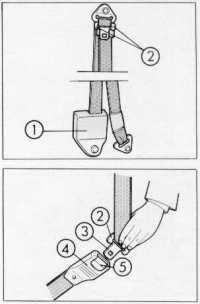It is important to wear seat-belts on
all journeys, including those in town.
It is also important to wear the belt correctly:
- the buckle must be to the side of the
hip, not above it;
- the belt must be a snug fit for the
wearer; a slacky-worn belt will not give its wearer the
protection intended. Automatic belts maintain correct fit while
allowing a certain amount of movement to the wearer.
- the belt straps must lie flat across
the wearer and must not be twisted;
diagonal straps should pass over the shoulder, not over the
upper arm;
- each belt is designed for one adult
occupant. Never use a belt for more than one occupant at a time.
Never put the belt around a child seated on the occupants lap.
|
- 1. Automatic inertia-reel seat
belts
| Fastening: |
- Take hold of the strap by the
catch tounge (2) and cross it over the body. This movement
should be performed smoothly so as not to lock the reel (1).
- Bring the tounge up to the buckle
(4), then insert until it clicks home.
|
| Adjustment: |
- These belts adjust automatically
to the wearer.
|
| Unfastening: |
- Press the red release button (5).
Take care not to let the strap retract too quickly, but
guide it back into its stowed position.
|
|
- 2. Static seat belts, lap and
diagonal
| Fastening: |
- Remove the catch tounge from its
holder by pushing it backwards.
- Cross the strap over the body so
as to bring the catch tounge in line with the buckle.
- Insert the catch tounge into the
buckle until it clicks home.
|
| Adjustment: |
- The belt should be close to the
body, without being too tight. Its length can be adjusted by
sliding the strap, using the adjustment buckle.
|
| Unfastening: |
- Press the red release button to
undo the belt.
- To put the belt back into
position, insert the catch tounge into its holder in the
stowed position.
|
|
|

Fig. 12 -
Automatic interia reel seat belts
1 - Reel casing
2 - Locking catch tounge
3 - Locking catch
4 - Buckle
5 - Red release button |
